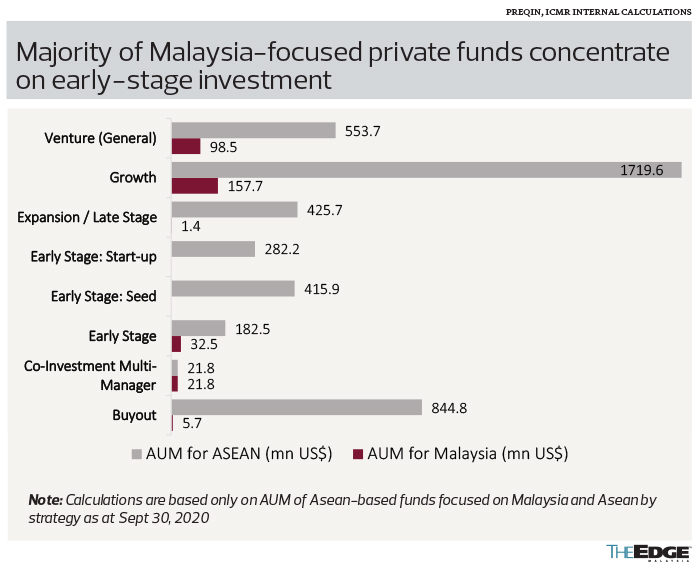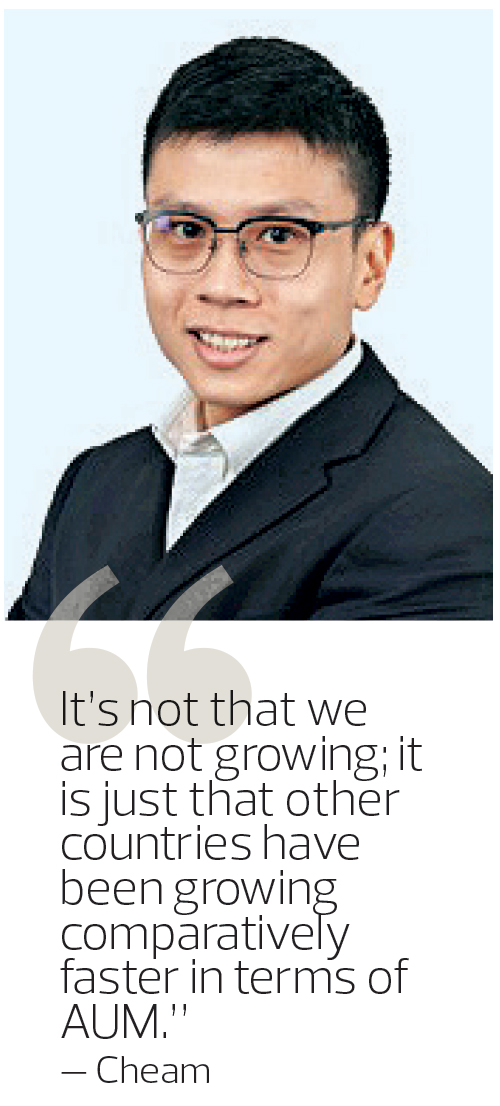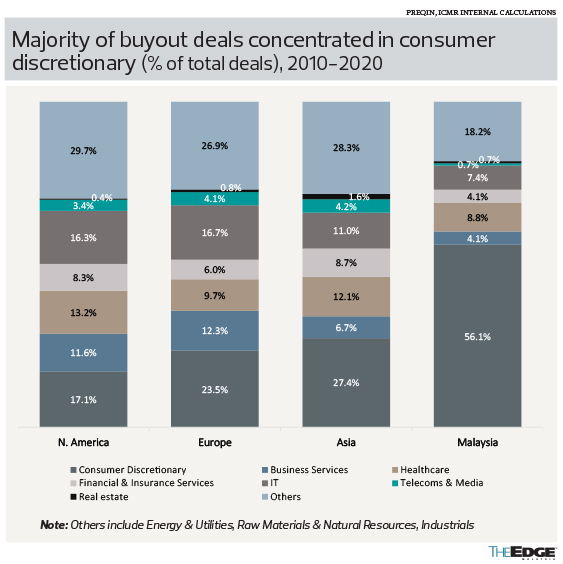
This article first appeared in Capital, The Edge Malaysia Weekly on January 17, 2022 - January 23, 2022
WHILE the global private equity (PE) industry has enjoyed strong growth over the last decade — driven by increasing investor allocations, market appreciation and outperformance of private firms compared with public companies — the industry in Malaysia has remained relatively sluggish.
According to the Institute for Capital Market Research Malaysia (ICMR), more needs to be done to grow the market. These include a healthier and more diverse ecosystem of fund managers and private investors to address the country’s rising liquidity needs.
“Venture capital (VC) is a subset of PE. Malaysia has established a good name for VC in this region over the last decade, but the growth of the local PE industry has been rather sluggish compared with that of the region and the world in terms of assets under management (AUM),” ICMR senior research analyst Cheam Tat Hong tells The Edge in a virtual interview.
While Malaysia Venture Capital Management Bhd (MAVCAP), Kumpulan Modal Perdana (KMP), Malaysian Global Innovation & Creativity Centre (MaGIC) and Cradle Seed Ventures have been established to nurture the VC industry, Cheam points out that less support has been given to the PE space, with only Ekuiti Nasional Bhd (Ekuinas) being established to spearhead the industry’s development.
For context, AUM for the global PE industry grew at a compound annual growth rate (CAGR) of 9% over the past decade to reach more than US$4.3 trillion in 2020, up from US$1.8 trillion in 2010.
In comparison, AUM for Malaysia’s PE industry has been growing at a slower pace of 6.7% annually, from US$3.7 billion in 2010 to US$6.8 billion in 2020. In contrast, some developed countries recorded a 10-year CAGR growth of over 10%.
In fact, the Asean region as a whole recorded growth of over 14.8% over the same period, with the advanced countries such as Singapore, Japan and South Korea posting even higher growth rates of 18.6%, 14.9% and 29.6% respectively.
Cheam acknowledges that the local PE industry is underperforming when compared with the regional and global PE industry, but understandably so.
“After all, it’s not that we are not growing; it is just that other countries have been growing comparatively faster in terms of AUM. I believe this is not a concern for Malaysia; but obviously, there is still room for improvement,” he remarks.
Cheam believes that it is not fair to compare Malaysia with the likes of the US, whose PE industry started about 30 to 40 years ago.
“Malaysia’s PE industry started probably 17 to 18 years ago, so it’s okay for us to grow at this pace. Of course, it’s hard to predict whether Malaysia will continue to underperform against the global markets in the coming decade, but the country will certainly benefit from Asean’s recovery and continued growth,” he says.
Offering his view from the perspective of a private capital practitioner, Vynn Capital founding and managing partner Victor Chua highlights that in Malaysia, most of the funding still comes from public funds such as the Employees Provident Fund (EPF), Kumpulan Wang Persaraan (Diperbadankan) (KWAP) and Lembaga Tabung Haji (LTH).
“Frankly, there are not many options out there. Of course, we have family offices and corporates, but it’s not easy for us to convince them to participate in our PE deals. In my view, Malaysia is a good place to look out for deals, but in terms of funding, we still have room for improvement,” he tells The Edge.
Today, says Chua, the majority of PE firms, even if they are not government-backed, are still raising funds from the public sector, relying on larger institutional investors such as the EPF and KWAP.
“Local corporates and the private sector, generally, are still complacent. There is not enough motivation to push the local corporates to take more risks. They are good at doing what they do, but most of them still have a wait-and-see mentality in risk-taking and private market investments,” he observes.
According to data provider Preqin, the global PE industry’s AUM growth is expected to continue its upward trajectory to reach over US$9 trillion by 2025, with Asia being a key driver. Notably, Asia’s share of PE activities has continued to advance from 9% of total deal value globally in 2010 to 17% in 2020.
Why Malaysia is an underperformer
ICMR is an independent think tank under the Securities Commission Malaysia and is funded by the Capital Market Development Fund.
ICMR’s report titled “Navigating Malaysia’s Private Equity Space: Challenges and Opportunities”, released in mid-December, identifies the need for a deepening of the ecosystem for late-stage financing in Malaysia.
ICMR’s Cheam says there are three main reasons why Malaysia’s PE industry has been underperforming against the global and regional PE industry.
First, the pool of experienced talent, or to be more precise, general partners (GPs), is not as deep as those in advanced markets.
“You can’t build an ecosystem with only a few GPs. We need to have a more diverse set of GPs in the country. Each asset class, be it VC or PE, requires different skill sets. Today, we have [fewer] than 15 active PE firms in Malaysia,” he explains.
Second, there is a lack of liquidity in the local PE industry.
“Although we have seen big deals like Columbia Asia Hospital, Ben’s Independent Grocer and Oriental Group of restaurants, the volume of PE deals is incomparable with that of other advanced markets,” Cheam says.
Third is the exit mechanism.
Divestment, or exiting an investment, is part of any PE investment process. Cheam opines that choosing the channel to exit is at the discretion of the GP and influenced by a variety of factors such as valuation, potential investors’ risk appetite, and what’s best for the investee company moving forward.
“If you look at other markets like Hong Kong and China, they have modernised their listing regimes to cater for new economy companies to raise capital. We are talking about dual-class shares, allowing pre-revenue companies to be listed, the special purpose acquisition company (SPAC) 2.0 framework and these kinds of things,” he says.
Vynn Capital’s Chua agrees.
“GPs and fund managers generally choose to reside in countries such as Singapore, where there is better liquidity. At the end of the day, we need to have enough capital for us to deploy into the right companies based on our investment strategies,” he says.
Chua admits that many investors still deem PE as high risk compared with public markets.
“When you are buying a stock, you can let it go within a day or even an hour. But when you are investing in PE, you need to look at a longer horizon. Generally, investors from Singapore and Indonesia are more receptive towards the idea of VC and PE because they see these as long-term asset classes,” he adds.
Currently, Malaysia’s PE industry is less diversified as most private funds target early-stage venture investments. As at September 2020, growth funds made up over 49% of total Malaysia-focused private funds, aggregating US$157.7 million in AUM. These funds typically take minority positions in investee companies without the use of leverage. Buyouts and late-stage strategies comprised only 1.8% and 0.4% respectively of Malaysia’s total private funds.
While capital is being actively deployed in search of attractive investment opportunities, most PE deals in Malaysia are concentrated in sectors such as consumer discretionary (56.1%) and raw materials/energy utilities (12%), unlike in other regions.
Although the Covid-19 pandemic has spurred private investors’ interest in other sectors such as technology and healthcare, ICMR notes that Malaysia still needs broader opportunities, especially in agriculture and financial and insurance services to address the growing challenges brought on by urbanisation, food security and infectious disease outbreaks.
Besides, more private investments are also needed in Malaysia’s halal industry to broaden existing verticals into areas such as pharmaceuticals, tourism and healthcare, as well as to deepen industry connections with regional and global supply chains.
Creating unicorns, and not letting them run away
While Malaysia has ambitions to create five unicorns by 2025, Cheam reiterates that the country needs to make sure that it has a stronger ecosystem, a bigger pool of funds to support the PE industry, a more facilitative environment, better ancillary services, and last but not least, a better exit mechanism.
“Obviously, Grab (Holdings Ltd) has gone to Singapore and now Nasdaq. But don’t forget, we still have two unicorns in the pipeline, namely Carsome and Aerodyne. It’s been proven that it is possible for Malaysia to create unicorns, and the last thing you would want to see is that after you’ve groomed a unicorn to a certain stage, they go for listing in other countries.
“But my point is, I really believe Malaysia has the right ingredients and entrepreneur quality to create more unicorns,” he adds.
Chua agrees that local fund managers also have the capability to identify and invest in companies that can become unicorns.
“Again, when we look at Grab, although its identity is controversial [whether it is Singaporean or Malaysian], the fact remains that it has Malaysian DNA. And I definitely agree with Cheam that we should also look beyond Grab because we still have some unicorns and unicorns in-the-making such as Carsome and Aerodyne,” he says.
It is worth noting that Vynn Capital and Chua are the early backers of Carsome, Southeast Asia’s largest online used car trading platform with a presence in Malaysia, Indonesia, Thailand and Singapore.
Chua was vice-president of Shanghai-based VC firm Gobi Partners before setting up Vynn Capital in 2018. He led Gobi’s investments in Carsome in 2016/2017, before Vynn Capital invested in Carsome in 2018.
“If we have more such successful stories, I am sure there will be more interest and excitement in the PE industry. Malaysia has plenty of entrepreneurs, opportunities and infrastructure. We just need to continue to push on and make sure that we are consistent,” he reiterates.
Chua urges the government and public sector to be supportive and play a bigger role in the development of the industry. But more importantly, the private sector should also step up.
“We need to encourage the private sector and corporates to look at PE and VC deals. Nowadays, some brick-and-mortar businesses are still reluctant to raise funds from PE deals because they don’t want to let go of their [control] and decision-making power,” he says.
Local tech firms, however, are open to raising funds from VC and PE because they like smart money from investors or strategic partners who can add value to the companies. “Generally, I don’t think it is a big problem for these investees. For technology companies, they are always looking at expansion; growth is still key.”
Save by subscribing to us for your print and/or digital copy.
P/S: The Edge is also available on Apple's App Store and Android's Google Play.




